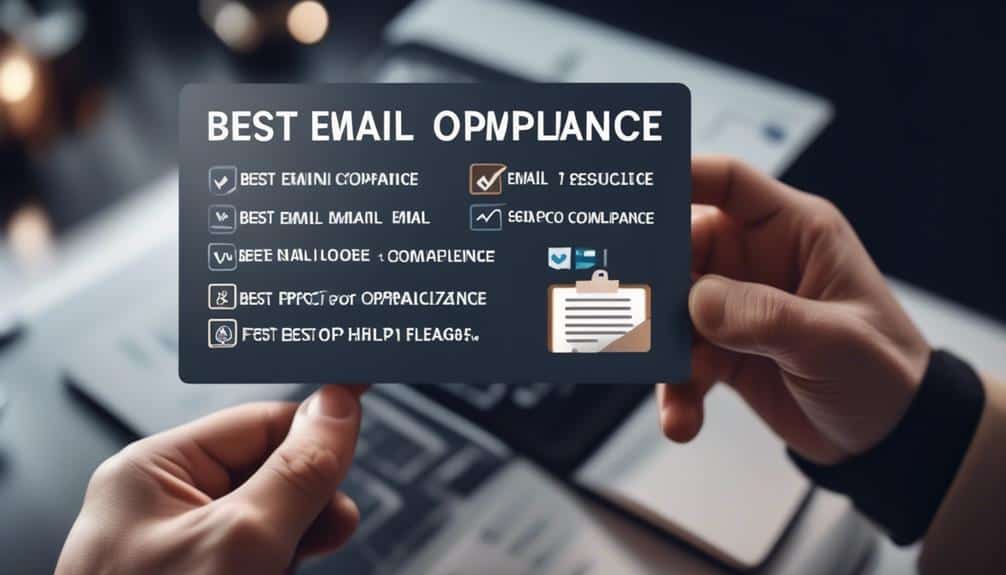Quick Guide to Email Compliance and Avoiding Blacklist Pitfalls
Imagine sending an email, only to have it vanish into the vast abyss of the internet, never to be seen or heard from again. It's a frustrating thought, isn't it? Well, the truth is, if you're not careful with your email compliance and blacklist pitfalls, this scenario could become a reality.
But fear not, for in this quick guide, we will navigate the treacherous waters of email regulations and share essential tips to ensure your emails not only reach their intended recipients but also stay out of the dreaded blacklist.
So, buckle up and get ready to discover the secrets of successful email delivery and compliance.
Key Takeaways
- Implement a clear and comprehensive email policy to ensure compliance with regulations.
- Regularly train employees on best practices and conduct compliance audits to identify areas for improvement.
- Follow legal requirements for email communications, including obtaining explicit consent, including an unsubscribe link, and providing accurate sender information.
- Monitor email deliverability and reputation, implement proper authentication protocols, and clean email lists to avoid being blacklisted.
Understanding Email Compliance

Understanding email compliance is crucial for businesses to maintain legal and regulatory standards. To ensure that your organization is following the necessary guidelines, it's important to be aware of a few key email compliance tips and have an email compliance checklist in place.
Firstly, it's essential to have a clear and comprehensive email policy that outlines the acceptable use of company email accounts. This policy should address issues such as email confidentiality, data protection, and employee responsibilities.
Secondly, it's crucial to regularly train employees on email compliance best practices. This training should cover topics such as identifying phishing attacks, avoiding the use of personal email for business purposes, and proper handling of sensitive information.
Furthermore, implementing email archiving and retention policies is vital for compliance. This ensures that all business-related emails are securely stored and easily accessible when needed.
In addition, it's important to regularly monitor and audit email communications to identify any potential compliance violations. This can be done through the use of email monitoring tools or by conducting periodic reviews of email content.
Lastly, it's crucial to stay updated on the ever-changing email compliance regulations and make necessary adjustments to your email policies and procedures.
Importance of Email Marketing Regulations
Now let's talk about the importance of email marketing regulations.
As a business, it's crucial for you to understand the legal requirements surrounding email communications. By following compliance best practices, you can ensure that your email marketing campaigns are in line with the law and avoid potential penalties or blacklisting.
Taking the time to familiarize yourself with these regulations won't only protect your business but also cultivate trust with your customers.
Legal Email Requirements
To ensure compliance with email marketing regulations, it's imperative to understand the legal requirements governing the use of email for marketing purposes. Here are five key legal email requirements that you need to be aware of:
- Consent: Obtain explicit permission from recipients before sending them marketing emails.
- Unsubscribe: Include a visible and easy-to-use unsubscribe link in every marketing email.
- Identification: Clearly identify yourself as the sender of the email and provide accurate contact information.
- Content: Ensure your email content is truthful, not misleading, and complies with relevant advertising laws.
- Privacy: Safeguard the personal information of your recipients and comply with email privacy regulations.
Compliance Best Practices
Implementing effective compliance best practices is crucial for ensuring the success and reputation of your email marketing campaigns. To maintain compliance, it's important to prioritize regular compliance training for your team. By providing your employees with the necessary knowledge and skills, they can navigate the complex landscape of email marketing regulations and avoid potential pitfalls.
Additionally, conducting regular compliance audits is essential to identify any gaps or areas for improvement in your email marketing practices. These audits help you ensure that your campaigns are aligned with industry standards and legal requirements.
Identifying Blacklist Pitfalls

Identifying potential pitfalls in blacklisting is crucial for ensuring email compliance and maintaining a secure communication environment. To help you navigate this terrain, here are five key items to consider:
- Monitoring: Regularly monitor your email sending practices to identify any potential triggers that could lead to blacklisting. Keep an eye on bounce rates, spam complaints, and other metrics that may indicate a problem.
- Authentication: Implement proper email authentication protocols such as SPF (Sender Policy Framework) and DKIM (DomainKeys Identified Mail) to verify the authenticity of your emails. This will help prevent your domain from being spoofed or used for malicious purposes.
- List Hygiene: Regularly clean your email lists by removing inactive or invalid email addresses. Sending to non-existent or inactive accounts can increase the likelihood of being flagged as spam.
- Reputation Monitoring: Use reputation monitoring services to keep track of your email sending reputation. This will allow you to promptly address any issues and maintain a positive reputation with ISPs and email service providers.
- Complaint Handling: Take complaints seriously and promptly address any issues raised by recipients. Responding to complaints in a timely and professional manner can help prevent your domain from being reported and subsequently blacklisted.
Email Deliverability and Reputation Management
Email deliverability and reputation management are crucial aspects of maintaining a successful email marketing campaign. Ensuring your emails reach the intended recipients and maintaining a positive reputation is essential to the effectiveness of your campaign. To achieve this, it is important to monitor your email reputation and implement proper email authentication methods.
Monitoring your email reputation involves regularly checking your sender score and monitoring any blacklisting issues. By staying aware of your reputation, you can take necessary measures to address any issues and prevent deliverability problems in the future.
In addition to reputation monitoring, implementing email authentication methods is vital for improving deliverability. These methods verify the authenticity of your emails, ensuring that they are not mistaken for spam or phishing attempts. Some common email authentication methods include SPF (Sender Policy Framework), DKIM (DomainKeys Identified Mail), and DMARC (Domain-based Message Authentication, Reporting, and Conformance).
By utilizing these email authentication methods and regularly monitoring your email reputation, you can enhance your email deliverability rates and maintain a positive sender reputation. This will ultimately lead to improved engagement and better results for your email marketing campaign.
| Email Reputation Monitoring | Email Authentication Methods |
|---|---|
| Regularly check sender score | Implement SPF |
| Monitor blacklisting issues | Utilize DKIM |
| Address reputation issues | Enforce DMARC |
Best Practices for Email Campaign Compliance

To ensure compliance with email regulations, it's crucial to have a clear understanding of the requirements and guidelines.
One of the key aspects is obtaining consent from recipients and ensuring they've opted in to receive your emails.
Email Regulations Overview
Understanding and adhering to email regulations is crucial for achieving email campaign compliance. To ensure that your email campaigns are in line with these regulations, there are several key factors to consider:
- Permission-based marketing: Obtain explicit consent from recipients before sending them marketing emails.
- CAN-SPAM Act: Familiarize yourself with the requirements of this U.S. law, such as including accurate header information and providing an easy unsubscribe option.
- GDPR: Comply with the General Data Protection Regulation by obtaining consent, providing clear privacy policies, and offering opt-out options.
- CASL: If you send emails to recipients in Canada, follow the requirements of the Canadian Anti-Spam Legislation, which includes obtaining consent and providing identification information.
- Email authentication: Implement measures such as SPF, DKIM, and DMARC to prevent email spoofing and protect your reputation.
Ensuring Consent and Opt-Ins
Before diving into the best practices for ensuring consent and opt-ins in email campaigns, it's essential to understand the importance of obtaining explicit consent from recipients and adhering to email regulations. Consent management is crucial for maintaining compliance and building trust with your audience.
Implementing effective opt-in strategies will help you obtain explicit permission from subscribers, ensuring that you have their consent to send them emails. One recommended approach is to use a double opt-in method, where subscribers confirm their subscription by clicking on a verification link in an email. This method ensures that only those who actively want to receive your emails will be added to your list.
Additionally, it's important to provide clear and transparent information about what subscribers can expect from your emails and how they can opt out if they wish to do so.
Avoiding Common Email Blacklist Triggers
Implementing effective strategies to avoid common email blacklist triggers is crucial for maintaining email compliance and ensuring the deliverability of your messages. To help you navigate this challenge, here are five important tips to keep in mind:
- Monitor your sending reputation: Regularly check your email deliverability and reputation metrics to identify any potential issues or red flags. This includes monitoring your bounce rates, spam complaints, and unsubscribe rates.
- Authenticate your emails: Implement email authentication protocols such as SPF (Sender Policy Framework), DKIM (DomainKeys Identified Mail), and DMARC (Domain-based Message Authentication, Reporting, and Conformance). These protocols verify the authenticity of your emails and help prevent spoofing and phishing attacks.
- Avoid spammy email content: Craft your email content carefully, avoiding excessive use of promotional language, misleading subject lines, and excessive capitalization or exclamation marks. Also, be cautious when including attachments or links, as these can trigger spam filters.
- Maintain a clean mailing list: Regularly clean your mailing list by removing inactive or bounced email addresses. This ensures that you're only sending emails to engaged recipients who are more likely to interact with your content.
- Monitor blacklists: Keep an eye on popular email blacklists and regularly check if your IP address or domain has been listed. If you find yourself on a blacklist, take immediate action to identify and resolve the underlying issue to improve your email deliverability.
Strategies to Maintain a Clean Email List

To maintain a clean email list, regularly perform list hygiene by removing inactive or bounced email addresses. This is crucial for ensuring that your emails reach active and engaged recipients. Inactive email addresses not only contribute to higher bounce rates but can also harm your sender reputation, leading to lower deliverability rates and potential blacklisting.
To maximize open rates and engagement, consider implementing strategies for email segmentation. By dividing your email list into smaller, more targeted segments based on factors like demographics, purchase history, or engagement level, you can tailor your content to better suit the interests and needs of each group. This personalized approach increases the likelihood of recipients opening and engaging with your emails.
Additionally, regularly monitoring and analyzing your email metrics is essential. Keep a close eye on open rates, click-through rates, and unsubscribe rates to identify any trends or areas for improvement. Use this data to refine your email marketing strategies and optimize your campaigns for better results.
Monitoring and Addressing Email Deliverability Issues
Regularly monitoring and addressing email deliverability issues is crucial for maintaining a successful email marketing campaign. By proactively managing these issues, you can ensure that your emails reach the intended recipients and achieve your desired goals. To help you stay on top of your email deliverability, here are five key practices to consider:
- Monitor your sender reputation: Regularly check your sender reputation to identify any potential issues that may negatively impact your email deliverability. Use reputation monitoring tools to receive alerts and take immediate action if your reputation starts to decline.
- Address spam complaints promptly: Actively manage and address any spam complaints you receive. Investigate the reasons behind the complaints and take steps to rectify the situation. This may involve reviewing your email content, ensuring opt-in compliance, or improving your sending practices.
- Optimize your email content: Create engaging and relevant email content that resonates with your audience. Use personalization techniques to make the emails feel more personalized and tailor them to the recipient's preferences. A well-crafted and enticing subject line can also significantly improve email open rates.
- Maintain a clean email list: Regularly clean your email list by removing inactive or unengaged subscribers. This helps improve your email deliverability and ensures that your messages are reaching the right people who are genuinely interested in your content.
- Monitor email open rates: Keep a close eye on your email open rates to gauge the effectiveness of your campaigns. Analyze the data to identify trends and make necessary adjustments to improve your open rates.
Staying Up-To-Date With Email Compliance Changes

Staying updated on email compliance changes is essential for ensuring your email marketing campaigns remain compliant and effective. As regulations and best practices evolve, it's crucial to stay compliant to avoid penalties and maintain a positive reputation with internet service providers (ISPs).
To stay compliant, it's recommended that you regularly monitor industry updates and subscribe to newsletters or join forums dedicated to email compliance. These sources will keep you informed about the latest changes and provide insights on how to adapt your email marketing strategies accordingly.
Additionally, it's important to review your email compliance policies and procedures periodically to ensure they align with the latest regulations. This includes obtaining proper consent from recipients, implementing opt-out mechanisms, and maintaining accurate sender information.
Frequently Asked Questions
How Can I Ensure My Email Campaigns Are Compliant With International Regulations?
To ensure global compliance with international regulations for your email campaigns, follow this checklist: familiarize yourself with laws, obtain consent, provide clear opt-out options, maintain accurate records, and regularly review and update your compliance practices.
What Are Some Common Mistakes That Can Lead to Email Blacklisting?
To avoid email blacklisting and optimize email deliverability, be aware of common mistakes like sending unsolicited emails, using spammy content, neglecting list hygiene, and not following email authentication protocols.
How Can I Improve My Email Deliverability and Reputation?
To improve your email deliverability and reputation, focus on email reputation management. Implement email authentication methods like SPF, DKIM, and DMARC to verify your emails and avoid being flagged as spam.
Are There Any Tools or Services Available to Help Monitor and Address Email Deliverability Issues?
There are several email deliverability tools and email reputation services available to monitor and address issues. These tools can help you track your email performance, identify any deliverability problems, and improve your overall email reputation.
What Are Some Best Practices for Staying Up-To-Date With Email Compliance Changes?
To stay current with email compliance changes, make sure to regularly check for regulatory updates. This will help you stay informed about any new requirements or guidelines that may impact your email marketing practices.
Conclusion
In conclusion, maintaining email compliance and avoiding blacklist pitfalls is crucial for successful email marketing campaigns.
By understanding the regulations, identifying potential pitfalls, and implementing best practices, you can ensure email deliverability and reputation management.
Regularly monitoring and addressing any deliverability issues, as well as staying up-to-date with compliance changes, will help you maintain a clean email list and achieve better results in your email marketing efforts.








